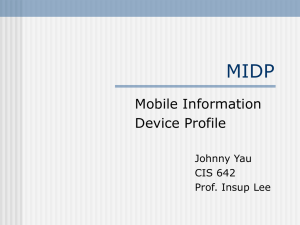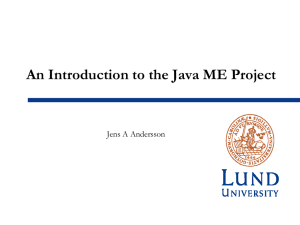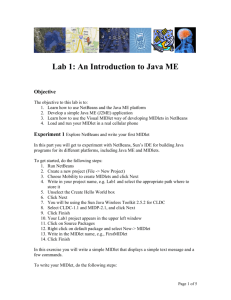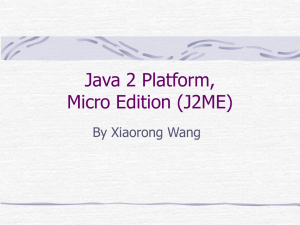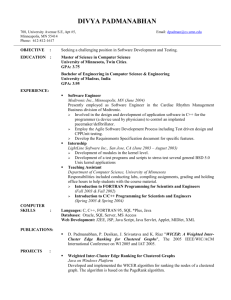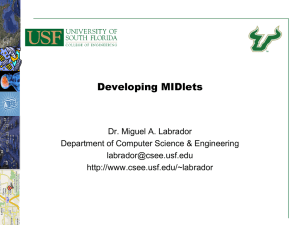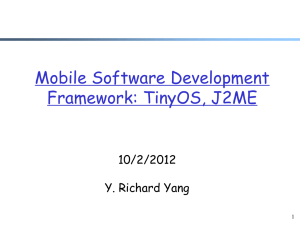Network Mobile fundamental and programming Third class
advertisement
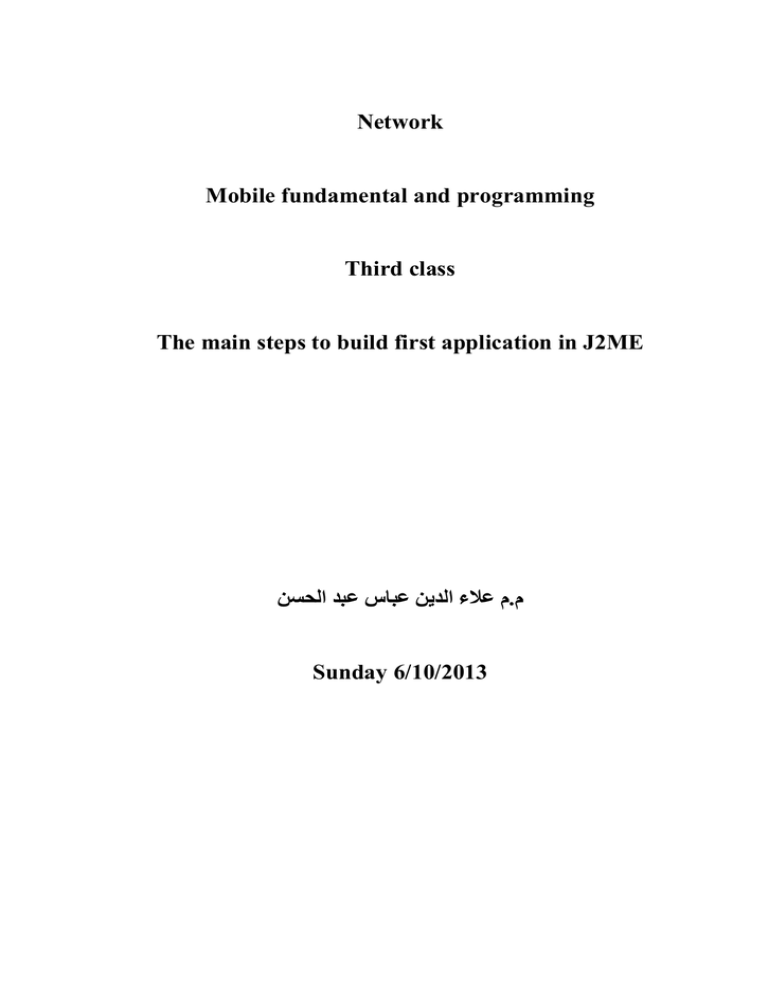
Network
Mobile fundamental and programming
Third class
The main steps to build first application in J2ME
م عالء الدين عباس عبد الحسن.م
Sunday 6/10/2013
The main library in J2ME are:
javax.microedition.lcdui: for user interface ,windows ,bottoms and textboxs.
javax.microedition.rms :storage methods on the main storage unit in the
mobile phone.
javax.microedition.midlet : MIDP and application environment.
javax.microedition.io: for communication framework
java.io :for input,output tool.
java.lang: for variables type.
java.lang.Boolean
java.lang.Byte
java.lang.Character
java.lang.Integer
java.lang.Long
java.lang.Short
Build the first program
In java and C we see that execution steps are begin from the
MAIN() function , where in J2ME is little deferent and well begin
from the STARTAPP() function for simple reason, that's it when
we write a program in java or c its enough to write the main
function to say to the compiler to begin from here .where in J2ME
we
extends
class
form
MIDlet
which
founded
in
javax.microedition.midlet and there are three abstract functions
(destroyApp , pauseApp , startApp) and one of programming
fundamental that the abstract function in extended class should be
completely written . for this reasons the main program well be
extended from the class MIDlet and well be start form
STARTAPP() function .
The MIDP Model and Lifecycle.
The MIDlet forms the application framework that executes on
CLDC devices under the Mobile Information Device Profile
(MIDP). Every application must extend the MIDlet class found in
the javax.microedition.midlet package. The application management
software (AMS) manages the MIDlet itself. The AMS is a part of
the device’s operating environment and guides the MIDlet through
its various states during the execution process. Unlike desktop or
server applications, MIDlets should not have a public static void
main() method. MIDlets are initialized when the AMS provides the
initial class needed by CLDC to start the MIDlet. The AMS then
guides the MIDlet through its various changes of state. We shall
look at these states next.
MIDlet States
Once a MIDlet has been instantiated, it resides in one of three
possible states. A state is designed to ensure that the behavior of an
application is consistent with the expectations of the end-users and
device manufacturer.
Initialization of the application should be short; it should be possible
to put an application in a non-active state; and it should also be
possible to destroy an application at any time. Therefore, three valid
MIDlet states exist:
PAUSED
The MIDlet has been initialized, but is in a dormant state. This state
is entered in one of four ways:
• after the MIDlet has been instantiated by the AMS invoking its
constructor; if an exception occurs, the destroy state is entered
• from the ACTIVE state, if the pauseApp() method is called by the
AMS
• from the ACTIVE state, if the startApp() method has been called
but an exception has been thrown
• from the ACTIVE state, if the notifyPaused() method has been
invoked and successfully returned.
When a well-written MIDlet is paused, it should generally release
any shared resources.
ACTIVE
The MIDlet is functioning normally. This state is entered after the
AMS has called the startApp() method. The startApp() method can
be called on more than one occasion during the MIDlet lifecycle.
DESTROYED
The MIDlet has released all resources and terminated. This state,
which can only be entered once, is entered for the following two
reasons:
• the destroyApp(boolean unconditional) method has been called by
the AMS and returned successfully; if the unconditional
argument is false a MIDletStateChangedException may be
thrown and the MIDlet will not move to the DESTROYED state; the
implementation of the destroyApp() method should release all
resources and terminate any running threads
• when the notifyDestroyed() method successfully returns; the
application should release all resources and terminate any running
threads prior to calling notifyDestroyed().
MIDlet Lifecycle Methods
The javax.microedition.midlet.MIDlet abstract class defines three
lifecycle methods:
• pauseApp() – this method is called by the AMS to indicate to the
MIDlet that it should enter the PAUSED state, releasing all shared
resources and becoming passive
• startApp() – this method is invoked by the AMS to signal to the
MIDlet that it has moved from the PAUSED to the ACTIVE state.
The application should acquire any resources it requires to run and
then set the current display
• destroyApp() – this method is called by the AMS to indicate to the
MIDlet that it should enter the DESTROYED state; all persistent
and state data should be saved and all resources that have been
acquired during its lifecycle should be released at this point;
generally, a well-written MIDlet will start up in the state it was in
prior to being shut down.
The Lifecycle Model
The various states of the MIDlet the Figure show how the AMS and
the MIDlet interface combine to form the lifecycle of the MIDlet:
1. The AMS creates a new instance of aMIDlet. The MIDlet’s
constructor is called with no argument and the application is put into
the PAUSED state. If any exception is thrown during this phase then
the application is put into the DESTROYED state.
2. The AMS calls startApp() to move the MIDlet into the ACTIVE
state. The MIDlet itself will at this point acquire any resources it
needs and begin executing.
3. Once the application is running, the MIDlet can move to two
other states:
• the MIDlet can be put into the PAUSED state by a call from the
AMS to the pauseApp() method The MIDlet will cease to be in the
ACTIVE state and choose to release some of the resources it
currently holds. If the programmer requires the MIDlet to pause,
then the MIDlet should first release shared resources (possibly
stopping any running threads) and then call the notifyPaused()
method.
• the MIDlet can move to the DESTROYED state The user or the
AMS decides that the application no longer needs to be running.
Game play may be finished, for example, or the AMS may have
decided that a process of a higher priority needs to claim the
resources being used by the MIDlet.
The first program
import javax.microedition.midlet.*;
import javax.microedition.lcdui.*;
public class HelloMidlet extends MIDlet
{
private Display display;
public void HelloMidlet(){}
public void startApp(){
display =Display.getDisplay(this);
System.out.println ("Hello world ");
display.setCurrent(form);
}
public void pauseApp(){ }
public void destroyApp(boolean unconditional){}
}
